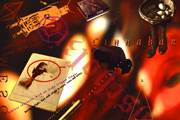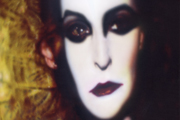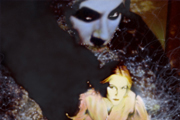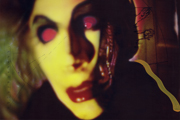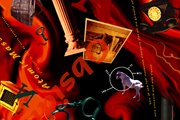Adventures in Art, Photography & Design
PHOTO | GRAPHIC | IMAGE | ARTS
Five unstructured and unrepentant ruminations on art, vision, signs, symbols, graphic depiction and photographic imagery.
SEEING DOUBLE
Human beings, like many creatures on earth, are endowed with binocular vision. Receiving visual data through two eyes separated in space, then comparing the slight differences in perspective, allow us (and other animals) to perceive the world as a 3-dimensional spatial environment. This 3-dimensional analogue of our surroundings, made visible by the thin slice of electromagnetic radiation our eyes are sensitive to, forms our sense of the visual "world".
The important thing for visual artists to remember is that the world we see with our eyes is not the actual world, but is a visual representation of that world that only exists in our minds. The world looks entirely different to a snake, a cat, a fish or a frog. It also appears differently to other people with poor eyesight, the condition of being "color blind", those with brain or nervous system damage, those under the influence of psychoactive drugs, and even those who perceive the world differently through training, culture or self-directed practice (such as cops, snipers, aboriginal hunters or birdwatchers, who learn to notice more details in their visual surroundings than the average person). It is incorrect to assume that everyone else sees the world the way we see it.
The personal sense we have of our 3-dimensional spatial and visual world is just that: personal. One of the insidious things about photography is that it has created a "baseline", a tacit agreement about what the world "looks like". Photography itself, and it's tacit agreement, influences how we perceive what we see. After a century of exposure to photographic images, we have a concept of how the world is supposed to look—and by extension, how we are supposed to look, (hence, the issues with eating disorders among young women). This concept has been defined by the optical/mechanical world of lenses, cameras, the film plane, film and/or digital sensors as well as the printing of images onto paper and displaying them on computer monitors and other types of digital displays.
We have no problem looking at a flat photograph and filling-in the spatial aspects of the subject with our understanding of how a flat image correlates with the world as we experience it through our innate sensory apparatus. The opposite is also true—in our real life, (one unmediated by man-made tools), we can experience a "view" of something, such as a city skyline, or an architectural detail, and "see" it as it would look as a photographic or cinematic image. Photographers and filmmakers do this all the time.
Isolated people who have never been exposed to photographic images, do not "read" those photographs as representations of actual physical objects in space. They see them as they actually are: a flat surface with complex patterns of colors arrayed across it, like the flat surface of a rock, a colorful leaf or a butterfly's wing. They do not naturally project space, or meaning, onto the flat patterns of color that comprise a photographic image. "Reading" a photograph is a learned response. They see photographs the way most of us see abstract paintings. For professional photographers and artists who work with photographic images, developing this ability to see a photograph as shapes, apparent textures and areas of color on a flat surface, and not as an image is a very valuable skill to acquire.
As we discussed in the last essay, what we refer to as images are created by our brains and nervous systems and only exist in our minds. The act of seeing images is something we learn, like a child learning how to speak a specific language, such as English, Russian or Chinese. Seeing images is a cultural act. This begs the question: can we learn different ways of seeing images? Are their multiple "languages of imagery"? Are there image dialects? Can someone be "multi-imagual"?
What's interesting is that these same questions could be asked of the imagery we see naturally through our eyes every day. Both are constructs that only exist in our minds. Like any construct, (languages, the patterns of sound pressure waves we call music, etc.), it is possible to form and differentiate different "families" and "forms" of imagery, just as we speak of early (pre-renaissance) music vs. punk rock.
Thus, imagery, and how we see images are not "givens". Images have no more a priori existence than languages or musical forms do. Imagery is a vehicle for mind-to-mind exchange invented by mankind. Imagery is an agreement.
Evil Twins
When we look out into the world using our eyes, we are actually taking in two different views and converting that into a 3-dimensional construct, an approximation of the 3-dimensionality of the world we inhabit.
When we look at a flat image, we are also creating a 3-dimensional approximation of the surface upon which the image lies (or is displayed). In other words, a photographic print may be high up on a wall, or lying down on a table. We understand the orientation of the print itself, and mentally make the necessary alterations, in real time, to still "see" the image as an image regardless of it's orientation in space. We grasp the image as if we were looking at it straight on. That photo of grandma is always grandma regardless of whether it is seen through an open doorway, displayed (at an angle) upon the mantle, or glimpsed upside down in a box.
This is a different kind of "persistence" than the persistence we discussed earlier. This is more akin to identity, or more specifically, the attribution of "identity" to an arrangement of hue, value and contrast on a flat surface. We have no problem recognizing "that" photo of a red sailboat, or "that" photo of one's cat or dog, even in conditions where the ambient light illuminating the image may be brighter or darker than normal. There would be no confusion if you wanted to grab the photo of your kids on the mantle on your way out of a burning house. The image itself becomes fixed in our constructed reality as if it were a real object. In many cases, images in the form of photographs are often valued more highly than any other physical objects, including houses, cars, clothing and furniture. Next to the kids and pets, what do people grab when forced to evacuate their homes? The family photos.
This is one of the things about images... they take on a subjective reality that is just as real as anything "out there" in the real world.
Again this is the result of some very complicated mental gymnastics going on inside our heads and has nothing to do with the photograph itself. In fact, any artist who has studied perspective drawing knows that drawing a picture of a "framed image" as if it were hannging on a wall in the "space" of a long gallery, is radically different than drawing that same "framed image" straight on. One, or the other, image could be considered "distorted".
If you distort an image, is it the same image?
Better yet, if you morph one image into another using animation software, at what point does the image of the bird become the image of your grandmother? What about all of the "in between" images? Are they not images in their own right?
If you project an image through a distorting lens (such as a glass bottle), so that the resulting projection is barely recognizable, is it the same image? How could it not be, given that the light that produced the original image is the same light that produces the resulting, "distorted" image? Can it be that a lens that merely distorts the path that a projected light takes toward a surface is itself capable of creating "new" images? Can a lens alone, without a camera, film, digital sensors or digital data storage create new images on its own, without human intervention?
We can ask the same question about a situation with no lens at all—just a simple hole, an "aperture", that allows light to pass through it—as in the case of a small pin-hole camera or a large pin-hole camera: the camera obscura.
If you think about these things, it becomes clear that every image has an nearly unrecognizable evil twin... in fact, an infinite variety of "twins", that may still be barely recognizable as the original image. At a certain point, that distorted twin image is no longer recognizable as having any relationship with the original image and will be seen as an entirely new image.
Thus, it is entirely possible to think of images as merely a point in an infinite continuum... every "image" as merely a frozen point in a continuous transformation into an infinite number of other images. Could it be that all images are actually the same image existing in different states?
Mirror Images
When an image is reflected, is it the same image? Is a mirror image of a mirror image the same image as the original image? Or is it different?
When light is reflected off of your face and enters a camera lens, it makes an image on the film plane, (or plane of the digital image sensor), no? Well... in many cases, the answer is, actually, no. Some cameras utilize mirrors, and some utilize prisms to bend or invert the path of the incoming light before it hits the film plane. Clearly, in such cases, the "image" has already been reflected or inverted before it hits the film plane.
Since this is the case, what we commonly refer to as an "image" is a pattern of light waves captured, or digitally "written" onto a flat surface... whether it has been mirrored or otherwise inverted, or not.
Yet... when you look at yourself in the mirror, have you noticed that you look different than you do in a photograph? Most of us do not have perfectly symmetrical faces, thus a photograph of our face appears different than a mirror image. Which one is the "correct" image, the real you? The reflection you have grown used to seeing in the mirror, or the image of yourself you see in photographs?
If the "camera does not lie" and we accept images that have already been flipped or inverted, does this mean that the photograph is more real than a reflection in a mirror? Does the mirror lie? Which do you trust more?
We also know that photographic images can be easily manipulated. What we call, "image manipulation" generally refers to changes made to the image after the photograph has been "taken". But what about the optical manipulations that occur via the lighting, lens or mechanical aperture of the camera system itself?
(On a side note, the language of photography is fascinating: we "capture" or "take" images prior to assigning them an "ID" and "storing" them away from light (as if in prison) so that they won't fade or "disappear"—or away from electromagnetic fields so that they won't become "corrupted"—prior to "manipulating" them, "exposing", "printing" and possibly "framing" them. Ask any cop, this is the nomenclature of criminality, force and hostage taking. Are we, in fact, somehow "abducting" images, and preventing their escape before abusing and/or converting them to our cause? Why have we created a mental framework, as revealed by language we use, to exert hostile force and control over images? At some deep level do we "apprehend" images as nominal sentient beings? Where does the language of hostility come from? In our minds, do we sub-consciously see, and project, ourselves as abusing, torturing and exerting control over images? Is photography a safe way to externalize sadistic impulses? Can images resist? Are images subject to Stockholm Syndrome?)If the lighting on the subject is bright and a wide aperture or long exposure is used, and a "blown out" image is captured, is that image manipulation? (This is a common tactic in fashion and music photography, both for it's dramatic look and because it hides all manner of skin imperfections nicely.) If a wide-angle lens is employed, instead of at telephoto lens, is the Image different, or has the "image" been "manipulated"?
Where, exactly, does the "image" lie? In front of the lens or somewhere behind it? Or, in the mirror? If the "image" is closely associated with the lit subject, in front of the lens, or in front of a mirror, we can say that everything described above is a form of "image manipulation". But if the "image" is only the post-photographic result, then "in-camera adjustments" are not really forms of image manipulation, are they? What about infrared film? Or color vs. black and white film? Are the images produced with such film inherently different than a "normal" image produced with a digital camera (or digitally scanned film) and then modified after the fact in Photoshop? We're not talking about common professional practice "production vs. post-production" conventions, we are discussing the very nature of the image, as opposed to our very loose ways of talking about images.
If we forget, for the moment, all this talk about lenses, cameras, film, digital sensors and image manipulation software, and simply define an "image" as anything we can see and potentially identify, then we could say that even turning on a light in a dim room is a form of "image manipulation". What about things we can "see" that don't have an identifiable subject? If you stand in front of a very large, smooth, evenly lit, white wall, do you see an "image"? If you lie down on a high mesa, and look up into a clear, blue, cloudless sky, do you see an "image". Intellectually, you know you are looking at a wall, or at the sky, but is there an image there? Are images incontrovertibly associated with a "subject"? What is the relationship between "seeing" and "image"? Can you see things that are "not images"? If they are not images, then what are they?
This seeing without seeing "an image" gets to the very heart of the work of the artist James Turrell, particularly his early installations of lit spaces. The viewer looks through a large rectangular opening in the wall, into the space beyond, featuring curved , (or "coved" to use some photo studio lingo), corners. The space is very carefully lit, so that one senses the space, but cannot see its boundaries (i.e., walls, floor, ceiling), or determine its dimensions. The effect is extremely disorienting, rather like the sonic disorientation of standing quietly inside a large anechoic chamber, as your eyes are clearly seeing but your mind cannot correlate the electro-chemical impulses coming from your eyes with any known "image" or space. Unlike looking into an empty room, where the empty room itself is the "image", with all associated spatial cues, with Turrell's Ganzfeld installations, you are "seeing" the absence of any image. Turrell's "void" installations focus attention on pure seeing, even more so than the color-field paintings of Marc Rothko, where the viewer, to more or less of an extent, is still aware of seeing a painting on the wall (an image of an object).
Plain Di-vision
Mathematically and biologically speaking, your retinas function as 2-dimensional sensors, therefore, the patterns of light that they capture and transmit are also 2-dimensional. As mentioned above, the impression of 3-dimensionality is created in our minds later, by comparing the slight differences in the light patterns coming from our two eyes. There is more offset in the two images for objects seen in close proximity to our eyes than in distant objects. This offset, and changing offsets (as in cases where we are moving through our environments) are used to create the strong subjective impression of space. Yet, fundamentally, our eyes do not directly apprehend space, our minds indirectly create our sense of visual space. This process is so smooth and continuous that we don't even notice it. We use this mental process to maneuver through our physical environment with only occasional incident. The kinesthetic aspect of this mental spatial illusion is key for maneuvering through an environment filled with moving objects. Just as some people have better eyesight than others, or a better 3-dimensional illusion making process than others, some have a better kinesthetic apprehension process than others.
We've all heard of cases where a traffic accident was caused by a slow, oblivious driver whose excuse was that they "didn't know where (the other driver) came from", or "I saw them far down the road, but then they were suddenly there". Of course this is a physical impossibility. The accident was, in fact, caused by neglect, (i.e., an observational lapse), or a mental, (i.e., visual, perceptual, kinesthetic processing), defect on the part of the slow driver.
If we examine situations where someone pulls out in front of another vehicle that is quickly approaching, the driver who caused the accident either: was not looking down the road for other approaching vehicles as they should be doing; or, they did check, but saw a vehicle in the distance and their brains didn't calculate that the "distant" vehicle was approaching very quickly. This is often the case with slow, timid drivers who don't realize that driving 30 mph slower than posted speed limits is nearly as likely to cause an accident as driving 30 mph above posted speed limits... or apparently oblivious drivers who pull out right in front of approaching vehicles. According to the Motorcycle Accident Cause Factors and Identification of Countermeasures study by researcher Harry Hurt at the University of Southern California, (USC), approximately three-fourths of the motorcycle accidents studied "involved collision with another vehicle, which was most often a passenger automobile", and "the failure of motorists to detect and recognize motorcycles in traffic is the predominating cause of motorcycle accidents. The driver of the other vehicle involved in collision with the motorcycle did not see the motorcycle before the collision, or did not see the motorcycle until too late to avoid the collision."
As a motorcyclist, I can attest that many drivers will look straight at you and then, at the last moment, pull right out in front of you, as if they are actually trying to kill you. This happens at least once on every single ride.
To put it bluntly, many car drivers who cause such accidents were not paying attention at the time of the accident, or, more troubling, have deficient mental and visual abilities to process 3-dimensional kinesthetic information in real time. According to the same study, (ironically, commonly referred to as The Hurt Study), "The likelihood of injury is extremely high in these motorcycle accidents—98% of the multiple vehicle collisions..." (i.e., collisions caused by oblivious drivers of passenger cars), "resulted in some kind of injury to the motorcycle rider". 45% of such injuries are severe injuries. Should drivers be tested for their kinesthetic processing ability, and those failing not allowed to receive a drivers license? Any motorcyclist, (and many bicyclists and even pedestrians), would say, "Hell, yes!"
It goes without saying that superior visual/3-dimensional/kinesthetic mental processing abilities are an absolute requirement for aircraft pilots, race car drivers, motorcycle racers, martial artists, rugby players and others whose life and continued well-being depends on the ability to move deftly through space filled with other moving objects, and elegantly avoid being hit by them. But how many lives would be saved, and injury avoided, by requiring all drivers to pass a basic test of their ability to comprehend space, distance, timing, relative velocity, directional changes, and points of intersection—in real time? One can correct poor vision, such as near-sightedness or astigmatism, with glasses, but there is no way to correct deficiencies in kinesthetic processing, with a simple prescription.. So, why do we expect, and accept, testing for one, but not the other?
Clinical Eye Examination
It is expected that people with bad eyesight, and even those who have enjoyed good eyesight their entire lives, but are aging and in need of reading glasses, should have their eyes examined on a regular basis. What if we could have our mental imaging, 3-dimensional processing and kinesthetic abilities examined on a regular basis as well? This is something that would be hugely valuable to artists, photographers, filmmakers, art directors and other visual professionals.
I stated above that it is not possible to address deficiencies in the perceptual abilities of our minds with a simple prescription. However, it is possible to enhance such abilities through consistent training, particularly if such training begins at a very young age. Playing sports, (most of which involve objects, including people, rocketing through space), is one way to enhance these abilities. Another is the "situational awareness" training that law enforcement officers and many taking classes in self-defense undergo. The key is consistent and continual practice.
Another form of "practice" in visual acuity and sensitivity is to look at images and watch films in an analytical context. If one enrolls in film school, a significant amount of one's training and education is spent watching, analyzing and discussing other people's movies, commercials, videos, etc. Yet, in total, during one's four years of college, how many films does one spend watching and discussing? A few dozen perhaps, at most a hundred.
Consider this: by the time they graduate from high school, (if they graduate), the average teenager has seen over three hundred thousand television commercials, television shows, movies, music videos and You Tube clips. So, why isn't every graduating high-school student a top-tier filmmaker, a budding Kubrick, Fellini, or Coppola? Through repeated observation alone, they should be professional-level experts in cinematography, lighting, acting, screen-writing, editing, music editing, special effects and everything else that goes into making a film, television show or commercial. So, why aren't they?
They weren't paying attention. Period. They were passive observers, mere consumers of media. They were not watching these films, videos or commercials like a future producer of media would watch them, with interest, with focused attention, analyzing what was happening and why, synthesizing exciting new ideas in the process. They were consuming, or worse, oblivious during those hundreds of thousands of hours—not observing, not comparing and contrasting, not thinking, not feeling, not remembering... not learning.
In a world that needs more and better communication, not less, this is a tragedy. The parents and teachers of these young people missed a gigantic opportunity. It is a loss for their media-consuming teenagers, and it is a loss for all of us.
.....................


